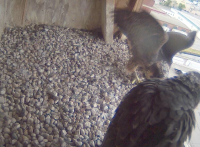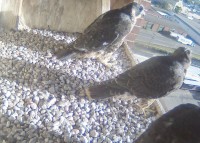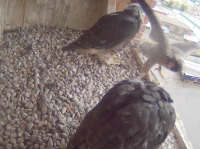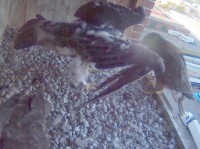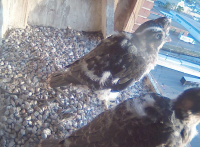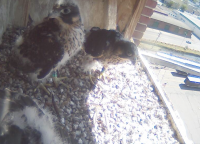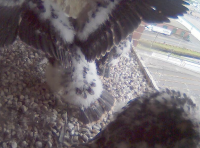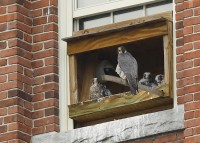Lawrence Peregrines: Day 43
June 16, 2019 in Near the Clock Tower
The remaining two Peregrines started off Father’s Day under overcast skies, light rain, and temp at 64F. The day ahead calls for mostly cloudy skies with a few scattered showers around midday and into the afternoon. Still mild, but a bit cooler than Saturday with highs around 70!
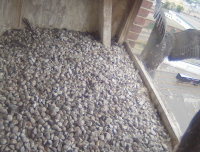 The two remaining chicks were seen in the nest box all day. They are so ready to make first flight! One of the chicks hopped out onto the perch pole and was flapping vigorously, but not quite ready to launch into flight. The web cam will continue to operate, but little chance we will see any further action through the cam. The chicks will be seen over the next many weeks in and around the area near the Clock Tower. The chicks will be learning to fly while the parents continue to feed them. The young falcon, as it launches into the world, is a most handsome bird, and when the last vestiges of down are shed from the head, it has the regal appearance of the adult. The eyes have by now, taken on that extraordinary quality of lustrous vitality and intense watchfulness that even the best paintings cannot capture in its fullness.
The two remaining chicks were seen in the nest box all day. They are so ready to make first flight! One of the chicks hopped out onto the perch pole and was flapping vigorously, but not quite ready to launch into flight. The web cam will continue to operate, but little chance we will see any further action through the cam. The chicks will be seen over the next many weeks in and around the area near the Clock Tower. The chicks will be learning to fly while the parents continue to feed them. The young falcon, as it launches into the world, is a most handsome bird, and when the last vestiges of down are shed from the head, it has the regal appearance of the adult. The eyes have by now, taken on that extraordinary quality of lustrous vitality and intense watchfulness that even the best paintings cannot capture in its fullness.
Literature cited:
Ratcliffe, D. 1993. The Peregrine Falcon. 2nd ed. Carlton, England: T. and A. D. Poyser.

